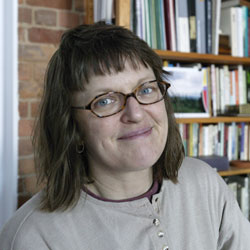At sunset, bending out the window
Knowing, sidelong, fields in the avenues
My eyes burn anyhow but I don’t care, I’m still reading
that Book by Erin Mouré.
How she makes me ache! She was a creek’s companion
lost south of St. Clair, a walking prisoner in the city’s freedom.
But the way she saw houses,
And the way she stopped short to look in the avenues,
And gave herself to things, in the same way
You’d gaze at trees,
And lift eyes down Vaughan Road to see where you’re headed,
And notice small crocuses pulse in the ravine.
She never speaks of that ache of sadness,
Never admits it,
Just walks downtown as if in a creek bed catching minnows,
Sad like flowers pressed flat in books
Or plants pressing up green, in yogourt jars …
Notes on the Poem
When poets overtly make themselves characters in their own poems, the effect can be intriguing and varied, occasionally verging on infuriating, but certainly never dull. The depictions can range from sly and witty, as illustrated in "I Interview Elaine Equi on the Four Elements", to surprisingly poignant, as evinced in this poem from Erin Moure's 2002 Griffin Poetry Prize shortlisted "Sheep’s Vigil by a Fervent Person". Celebrites and professional sports figures are not infrequently heard referring to themselves in the third person, but the act of illeism as they wield it is rarely as intended, an act of humility. The practice typically has the opposite effect, coming across as false, pretentious and patently immodest. How then does Moure use this approach to such touching effect? Expressing something from a first person perspective seems very personal and close. In contrast, using third person theoretically distances you from any feelings ... but isn't the following imbued with wistfulness? "But the way she saw houses, And the way she stopped short to look in the avenues, And gave herself to things, in the same way You'd gaze at trees, And lift eyes down Vaughan Road to see where you're headed" The poem addresses another person (the second person "you" that seems particularly pronounced juxtaposed with the third person "she") who is clearly no longer there. This seems to further intensify the poem's emotional undercurrent. The contrast of crocuses so alive they're pulsing in the ravine compared to dead flowers pressed flat in books even further accentuates the distanced narrator's sadness (she mentions "ache" more than once). Although they are pathetically housed in "yogourt jars", are the plants in the last line a faint sign of optimism, or is poor Erin Moure bereft of hope?
